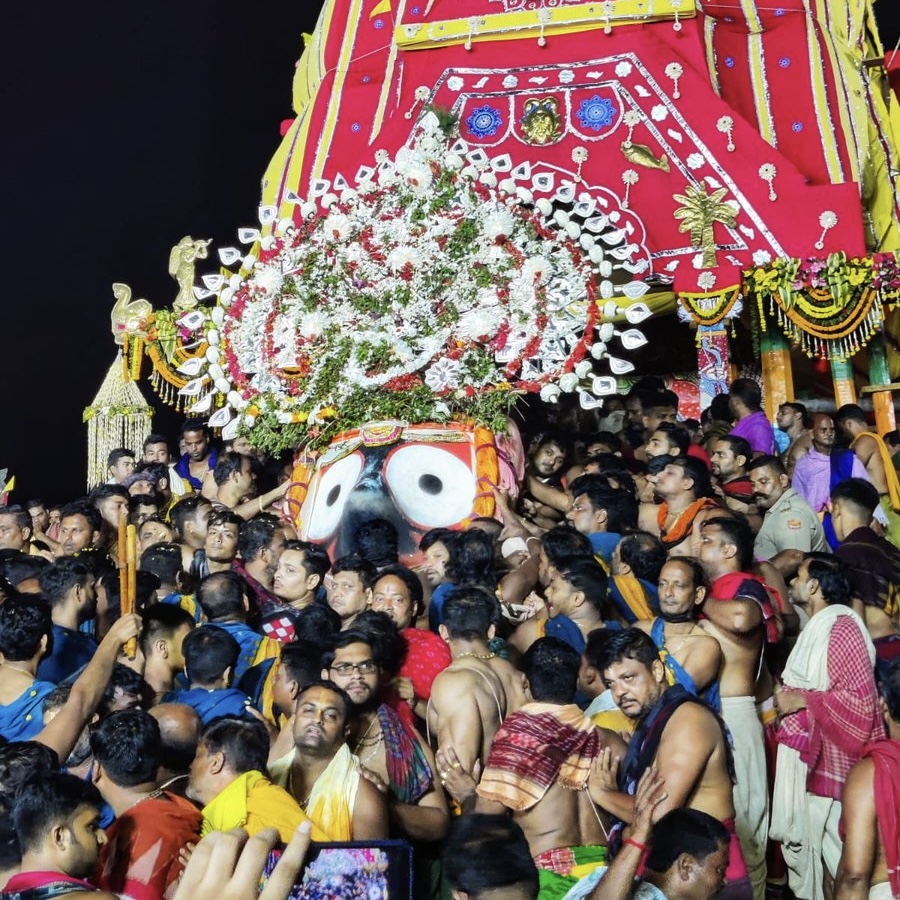The spiritual aura of Puri, one of the holiest cities in India, is eternally illuminated by the presence of Lord Jagannath, the Lord of the Universe. Among the many grand rituals and divine traditions that unfold in the sacred precincts of the Jagannath Temple, one that marks the culmination of the world-famous Rath Yatra is Niladri Bije—the ceremonial return of Lord Jagannath to His original abode, the Sri Mandira (Jagannath Temple).
Niladri Bije is more than a ritualistic procession; it is a deeply symbolic, emotionally rich, and culturally profound event that encapsulates the divine love between Lord Jagannath and Goddess Lakshmi. It is a celebration of reunion, humility, penance, and grace. This article explores every facet of Niladri Bije—its origin, rituals, spiritual meaning, and the stories that make it an inseparable part of Odisha’s heritage.
What is Niladri Bije?
Niladri Bije literally means “Entry to the Blue Mountain.” In this context, “Niladri” refers to the Jagannath Temple, believed to be situated on the mythical Neela Parvat (Blue Mountain), and “Bije” means “entry” or “return.”
Niladri Bije is the final event of the Rath Yatra (Car Festival) and takes place on the 11th day of the lunar fortnight of Ashadha (known as Ashadha Shukla Ekadashi). It marks the return of Lord Jagannath, Lord Balabhadra, and Goddess Subhadra to their sanctum sanctorum after a sojourn at the Gundicha Temple—their aunt’s house—for nine days.
This return, however, is not straightforward. It involves a dramatic and highly symbolic episode between Lord Jagannath and Goddess Lakshmi, filled with divine emotions and cosmic metaphors.
The Origin of Niladri Bije: Myth and Meaning
The origins of Niladri Bije are deeply embedded in Jagannath mythology and Vaishnavite traditions. According to Skanda Purana and temple lore, Goddess Lakshmi, consort of Lord Jagannath (a form of Lord Vishnu), feels ignored and abandoned when Jagannath leaves for the Rath Yatra without informing her or inviting her to accompany Him.
In response, Lakshmi decides not to let Him re-enter the temple unless He acknowledges His mistake and offers a peace offering. Thus, Niladri Bije becomes not just a homecoming, but a ceremonial reconciliation—a beautiful portrayal of the divine relationship between the masculine and feminine cosmic forces.
The Symbolic Narrative: A Divine Domestic Drama
The Niladri Bije ritual is infused with human-like emotions that make the divine accessible to devotees. It is a portrayal of separation, love, forgiveness, and restoration of harmony.
When Lord Jagannath tries to enter the temple with His siblings, He finds the door locked by Goddess Lakshmi. She is visibly displeased. In an effort to appease her, Jagannath offers her Rasagola (a sweet delicacy). Only then is she pacified, the doors are opened, and the Lord is allowed to return to His sanctum.
This episode of reconciliation is popularly known as the “Rasagola Utsav” and has become an integral part of Niladri Bije. The offering of Rasagola has now taken on cultural significance in Odisha, celebrated annually with pride and devotion.
Step-by-Step Rituals of Niladri Bije
The rituals of Niladri Bije are meticulous, vibrant, and spiritually intense. They symbolize both cosmic cycles and deeply human sentiments:
1. Preparations for Return
After completing their stay at the Gundicha Temple, the three deities—Jagannath, Balabhadra, and Subhadra—are placed back on their respective chariots stationed in front of the temple.
The atmosphere is electric, with devotees lining the Bada Danda (Grand Road), singing devotional songs and offering prayers for the safe return of the Lords to their home.
2. The Procession Begins
The chariots are pulled once more, and this time, the direction is toward the Jagannath Temple (Sri Mandira). As the chariots roll, the joy among devotees intensifies, but everyone awaits the moment of Jagannath’s confrontation with Lakshmi.
3. The Blocking of the Entry
As Lord Jagannath reaches the Lion’s Gate (Simha Dwara) of the temple, He is met with resistance from Lakshmi’s servitors. They block His entry as per Lakshmi’s divine command. This ritual enactment is carried out with theatrical flair, where Lord Jagannath is symbolically made to admit His error.
4. Rasagola Offering
To express His remorse and win back Her affection, Lord Jagannath offers Rasagolas to Lakshmi. This act of appeasement is central to Niladri Bije. Upon receiving the offering and being pacified, Lakshmi permits Jagannath to re-enter the temple.
This part of the ritual is a profound symbolic act: it reminds us that pride, ego, or neglect can be overcome only through humility, love, and offerings of sweetness—both literal and metaphorical.
5. Entry into the Sanctum
After reconciliation, Jagannath, followed by Balabhadra and Subhadra, is ceremonially carried back into the sanctum, marking the end of the divine journey that began with Rath Yatra.
This return to the temple is not just physical—it signifies the restoration of cosmic order, the reunion of divine energies, and the re-establishment of harmony in the universe.
The Cultural and Emotional Depth of Niladri Bije
Niladri Bije is not only a religious ritual; it is a living cultural tradition of Odisha. It represents:
- The dynamic relationship between divinity and humanity, where the gods mirror human emotions and social customs.
- The strength and dignity of the feminine divine, where Lakshmi, the goddess, holds Lord Jagannath accountable.
- The celebration of forgiveness and love, symbolized through the sweet Rasagola.
It also underlines the idea that even the highest divine force bows to love and grace, not dominance.
Niladri Bije and the Rasagola Controversy
In recent years, Niladri Bije gained national attention due to the “Rasagola controversy”—a cultural debate between Odisha and West Bengal regarding the origin of Rasagola. Odisha’s strong claim is rooted in this age-old ritual, where the offering of Rasagola is an essential and ancient part of the Jagannath tradition.
In 2019, Odisha received the GI (Geographical Indication) tag for “Odisha Rasagola,” confirming its unique identity and long-standing association with the Niladri Bije ritual. Thus, what began as a divine offering has now become a cultural emblem of Odisha’s heritage.
Philosophical Symbolism
The Niladri Bije ritual is rich in Vedantic and Tantric symbolism:
- The journey of Jagannath signifies the soul’s departure into the material world (Gundicha) and its eventual return to the Supreme (Sri Mandira).
- Lakshmi’s resistance symbolizes the cosmic check against imbalance, reinforcing the interdependence of masculine and feminine energy.
- The reconciliation emphasizes love, humility, and surrender as the true paths to divine grace.
Conclusion
Niladri Bije is more than a festival. It is a divine drama that brings together theology, emotion, culture, and ritual. Through the intimate relationship between Lord Jagannath and Goddess Lakshmi, devotees witness the eternal play of love, forgiveness, and cosmic harmony.
As the chariot wheels cease and the Lord enters His abode, a powerful silence descends on Puri—a silence that echoes with the sweetness of Rasagola, the joy of reunion, and the spiritual wisdom that even the Divine submits to love.
Niladri Bije teaches us that divine relationships are not beyond human understanding—they are reflections of the truths we live by, made sacred through stories, rituals, and enduring faith.


